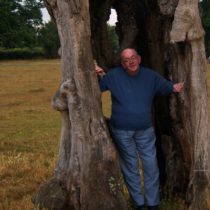Landscape Architecture for Landscape Architects › Forums › GENERAL DISCUSSION › Outdoor Fireplace Standards
- This topic has 1 reply, 8 voices, and was last updated 13 years, 8 months ago by
 Nick Panetta.
Nick Panetta.
-
AuthorPosts
-
April 11, 2012 at 3:34 pm #157855
 Miles BarnardParticipant
Miles BarnardParticipantI’ve been working on a fire pit design and the client is now considering morphing the pit design into more of a fireplace. We are considering going to a fireplace design because we are worried about the smoke issue, knowing that something with a chminey will draw the smoke away from the space where a firepit design will always send smoke into somebody’s eyes. So here’s the question: Does anybody have input on what the minimum chimney length could be and still have draw? In other words the minimum distance from top of firebox to top of chimney. I’m trying to minimize the height of the overall structure. If anybody is interested I have attached a drawing of the current pit design. -Miles
April 11, 2012 at 5:55 pm #157865 Nick PanettaParticipant
Nick PanettaParticipantIf smoke in the eyes is the issue, have the stack terminate higher than six feet. Unless wind carries it, smoke goes up : )
April 12, 2012 at 3:32 am #157864 Robert AndersonParticipant
Robert AndersonParticipantMiles,
Its really a matter of getting the draw to start from there the heat carries the column of smoke up. We have a chiminea that is – by design intended to make smoke – and the “flew” is only 24 long. This carries the smoke away from everyone except on the windiest of days.
Good luck with your project.
Robert
April 12, 2012 at 10:26 am #157863 Miles BarnardParticipant
Miles BarnardParticipantRobert thanks for the feedback. In studying the chiminea I’m thinking that part of the success in these having draw is related to the small front opening into the firebox. Do you think?
April 12, 2012 at 12:19 pm #157862 Les BallardParticipant
Les BallardParticipantA yard with a draft pipe and depth of a fireplace.
Several thousand years ago folk decided that it was a good idea to put a hole in the roof of their roundhouse to let the smoke out but, fireplaces as such did not really get going until a thousand years ago. Quickly then, however, they found that one of the most important things to put in a fireplace was a tube from outside to provide a draft under the grate. This inflow of air, combined with the direction the grate faced if there was other wind or drafts (prevailing wind direction if outdoors), also the invention of firebricks following the use of stone as a natural radiator and bread oven, were all important. Folk forget the draft pipe these days even in household fireplaces which is a shame. Nowadays, indeed, people may want something stylish in stainless steel that immediately blues in the hot spots, or with a copper hood or even incorporating an Italian pizza oven at enormous expense. A lot depends on the clients and what they expect but, often, this might be a fire one side for warmth, where there is also seating and shelter from winds – including those made by nearby buildings – and a bbq behind or to the side and this could be as much as folk care. In the UK there is standard urban height restriction for fences, etc. of 2 metres above ground but that does not mean you cannot put a flue in a chimney base to reach a fathom above ground starting from a point below it. That is to say you could make a big hole in the ground (with a drain) to take minimal foundations for a sort of fake ruin with fireplace that requires you to walk down a slope to the bbq and to one side, maybe, to remove ashes from below the grate and have the fire hole to warm diners above ground level. Slope sides might be a double wall to grow herbs in, of a variety most needed for what is often cooked. It still means the chimney or flue is relatively short, perhaps sporting a cowl on top. The air pipe to provide a draft is easy to install but the distance the air travels through the fire, to where the flue proper starts, is greater from below ground level and provides more of a draw. What you have in there by way of a damper is up to you and that is usually in the fireplace, not the flue, unless you can buy attached ones. Either way, you need a nice long poker to open and close it and some lighting attached to a new fuse / ring main that does not get interfered with by heat from anywhere. This may sound obvious but it is a new part of the total project, not the same part, and as might be a water feature, though while you are digging a hole a separate hose or plastic pipe to contain cable can be installed. All these complications, costs and the small size of many properties in the UK explains why chimineas have become popular here, as have gas space heaters for domestic areas (and pavement cafes) and bbq units (and people do not know how to make and tend those, let alone a real fire, any more).
My mind wanders to visions of creating a lake, with an island, on which is a folly-like castle ruin and piazza, by a dragon form open fire, a fountain, a hot tub or sweat lodge and plunge/shower, a gaily painted bridge with carved fairy statues and elf-form light holders in the trees, also holding surround sound speakers or whatever but, usually, folk only want to pay for a couple of metres of wooden decking and a few bricks to support a gas bbq and not even thinking of the space between them that could stop one setting light to the other. Whatever you manage in addition, more power to your elbow.
April 12, 2012 at 7:25 pm #157861mark foster
ParticipantMy understanding is that the “draw” considerations required for an indoor fireplace are not needed in an outside one, because temperature and pressures differences don’t exist like they do inside a structure.. All of the pre-manufactured outdoor fireplaces I have installed or seen reinforce this: they are really simple— nothing but a straight flu, no damper, smoke chamber, parabolic throat etc, and their openings are much larger in relation to flu size than indoor systems.
The only thing I have seen which affects the “draw” has to do with the prevailing winds interacting with nearby buildings. These can be really tricky.
April 13, 2012 at 11:59 am #157860mark foster
ParticipantTo expand on your question. The pre-manufactured masonry fireplaces are usually about 8′ tall (total height) with a chimney heigh (from top of firebox to top of chimney) of about 3 1/2-4′. I have never had a fireplace “backdraft” from the firebox outward–smoke problems happen when the wind pushes down the smoke after it comes out of the top of the chimney. Both pre-manufactured and those built from scratch have performed about the same.
The good news: you can build and test it, and if you need to add to the chimney height you can, without affecting performance.
April 13, 2012 at 2:41 pm #157859 Jordan LockmanParticipant
Jordan LockmanParticipantThere are some good prefab kits out there. That might save you some heartburn.
April 18, 2012 at 4:17 am #157858 Nicholas YoungParticipant
Nicholas YoungParticipantFrom my experiences it is not the draw from a chimney that you should be concentrating on. Smoke is always going to occur from a fire, you just need to control it enough so it does not get into everybodies eyes. HOW? great question, I am glad you asked… Control the wind and you control the dirrection of smoke. This can be done with a screen of some sorts close to your pit, or it your clients budget is a bit bigger a stone feature wall. BOOM problem solved.
April 18, 2012 at 10:32 am #157857 Andrew Garulay, RLAParticipant
Andrew Garulay, RLAParticipantI spoke with a mason about flue size two days ago. I did not ask him anything about chimney height or any specifics, but he told me that the flue size is calculated based upon the opening of the fireplace and chimney height. It does not answer your question, but it does tell you that there is an actual formula and you have an additional variable (flue size) that can be used to help make your chimney height work.
April 18, 2012 at 8:30 pm #157856mark foster
ParticipantTry masonryinstitute.org. I know they have inside fireplace specs–may have outdoor ones too.
-
AuthorPosts
- You must be logged in to reply to this topic.


